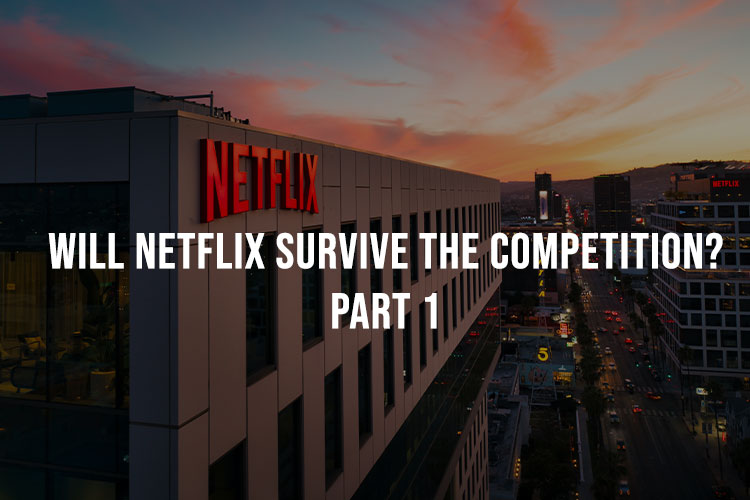It’s pretty crazy looking back at the time when Netflix took the world by storm. They brought binge-watching to the mainstream.
Before Netflix, people used to wait for a show to come out on DVD, and they had to get up from the couch to change the disc after every couple of episodes. The fact that this was a reality is insane! But, then Netflix came along and changed everything. It puts all those episodes in one place, so all you have to do now is click play, and then chill. Netflix started out as a DVD shipping company in 1997, and was created by Reed Hastings. Netflix consumes more than 15% of worldwide bandwidth today. With an idea to cut the cords on how people traditionally viewed media, these streaming giants changed the entire entertainment industry.
How did Netflix change the way we stream?
Netflix competitive advantages have been a significant contributor to its success. With the power of technology and personalization, Netflix has taken the game too far out of everyone else’s reach. Leveraging its powerful backend algorithms and recommendation engines, Netflix knows what its audience wants and serves them with precision. This has enabled Netflix to create a loyal customer base that values its ability to deliver a personalized viewing experience.
If there is one thing that this streaming behemoth is known for, it is the high quality of the original material it produces. Netflix’s competitive advantages have allowed it to create world-class original shows for the past ten years, beginning with Lilyhammer in 2012. House of Cards, Orange Is the New Black, Stranger Things, The Crown, Money Heist and a slew of other gripping shows are all a testament to Netflix’s unique strengths.Earlier television networks used to pick and broadcast shows based on pilots. Netflix altered this procedure by awarding creators with contracts that included the making of full seasons, thanks to its competitive advantages. This has resulted in a plethora of fantastic series and films coming out every month, giving subscribers a consistent stream of content to enjoy.
In spite of all this, Netflix competitive advantages have not shielded it from the challenges of a saturated market. Last year, Netflix’s subscription growth slowed dramatically, following a record year in 2020 when the world’s most popular video streaming service added 36 million subscribers to its roster. Nonetheless, the company added 8.3 million customers in the last three months of 2021, bringing the year’s total subscriber growth to 18.2 million. This is the lowest annual membership growth since 2016, when Netflix added around the same number of new subscribers. While this may appear concerning at first glance, there’s no need to fear the demise of Netflix just yet.
Building your business success with our strategies and solutions.

Building your business success with our strategies and solutions.
Increase your Sales: Lets boost your sales with irrestible marketing tactics
Control your expenses: Take charge of your expenses and optimize your performance.
Build your team: Partner with us to build a high-performing team for your business
How did Netflix beat rivals like Blockbuster and survive the 2000s?
Netflix competitive advantages have been the driving force behind its success. It all began when Reed Hastings grew annoyed with the exorbitant late fees that Blockbuster was charging to customers renting their DVDs. As you are aware, Netflix began as a DVD shipping company, thanks to its unique strengths. However, during the start of the 2000s, Netflix was fighting for relevance, which seems hard to believe now. Despite squandering more than $50 million in 2000, struggling to reach even 300,000 users, and abandoning plans to go public when the dot-com boom took place, Netflix persevered and continued to grow, thanks to its competitive advantages.The company’s fate was first put in the balance when, in 2004, its arch-nemesis Blockbuster announced that it would also begin to deliver/ship DVDs to its customers. However, Netflix’s competitive advantages proved to be superior to those of Blockbuster. With Blockbuster’s huge network of stores and services, they had the ability to crush Netflix in just a few months. But Netflix’s unique strengths, including its powerful backend algorithms and recommendation engines, allowed it to continue delivering a personalized viewing experience to its customers, something that Blockbuster could not match. Netflix’s competitive advantages enabled it to not only survive but thrive, while Blockbuster eventually went bankrupt.
Netflix’s journey to the top was not easy, but its competitive advantages enabled it to overcome challenges and emerge as the world’s most popular video streaming service. Today, Netflix’s high quality of original material, combined with its ability to serve its audience with precision, is a testament to the power of its competitive advantages. Despite the challenges of a saturated market, Netflix’s competitive advantages will likely continue to play a significant role in its future success.
However, Netflix was able to flip the script to beat out its then competitors. With 130 million customers in nearly 200 countries, a growing portfolio of award-winning programmes, and a market capitalization of more than $150 billion, Netflix now dominates the entertainment scene. That’s comparable to Disney. And what about Blockbuster? It declared bankruptcy eight years ago and now has just one store left.
Netflix outsmarted Blockbuster and other competitors like Walmart by reacting rapidly to technological advances. According to interviews with current and former Netflix executives as well as industry analysts, the company’s biggest triumphs arose from a nearly unparalleled willingness to upend the business when larger competitors hesitated.
It was because of Netflix’s first-mover advantage that the company was able to maintain price rises in the past. Netflix is now up against Amazon Prime Video, HBO Max, Disney and Hulu, and the rivalry is just about heating up. In the next two years, NBCUniversal (CMCSA), and Time Warner (T) will all launch their own streaming services.
The streaming ambitions of Disney, in particular, pose a serious challenge to Netflix. On the company’s latest earnings call, Disney CEO Bob Iger stated that a bundle of Disney+, ESPN+, and ad-supported Hulu media will be available for $12.99 per month, the same price that Netflix charges in the United States. Disney’s enormously famous tentpole franchises give them a substantial edge in the streaming wars, and their ability to bundle that content with live sports and popular third-party programming is a major competitive advantage, as argued in “Disney’s Avengers Spell Endgame for Netflix.“
How competition is rising for Netflix
Netflix competitive advantages in producing quality original content and utilizing their powerful recommendation engines have been key to their success. They won seven Academy Awards in 2021, the most out of any of their streaming service competition, and offer their subscribers high-quality entertainment 24/7. Despite these strengths, Netflix faces stiff competition from a pack of large competitors. A competitive analysis can provide insights into these competitors and how Netflix can continue to leverage its advantages to maintain its dominant position in the industry.
| Competitor | Revenue | Users | Countries |
| Amazon Prime Video | $ 25.21 Billion | 200 million | 22 |
| Youtube TV | $ 19.8 Billion | 3 million | 65 |
| Disney+ | $ 17 Billion | 116 million | 53 |
| Paramount+ | $ 6.87 billion | 42 million | 54 |
| HBO Max | $ 6.8 Billion | 69.4 million | 51 |
| Hulu | $ 3.5 Billion | 42.8 million | 2 |
| Showtime | $ 986 Million | 28.5 million | The US |
| Apple TV+ | $ 912 million | 40 million | 107 |
| Sling TV | $ 178.1 million | 2.44 million | The US |
| Curiosity stream | $ 71 million | 20 million | 176 |
Netflix competitive advantages in producing quality original content and utilizing their powerful recommendation engines have enabled them to establish their dominance in the industry. However, they are facing strong competition from competitors with significant revenues, large user bases, and formidable banks of original content. To maintain its position, Netflix needs to leverage its competitive advantages and find ways to innovate and differentiate itself from the competition. Part II of the blog will explore how Netflix can compete and overcome the competition, just like it did the last time around.



